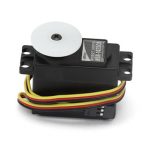Hitec HS-1425CR Continuous Rotation Servo


The HSR-1425CR is a special motor manufactured to operate as a continuous rotation servo. Dual ball bearings on the output shaft ensure long lasting performance. Essentially, it is a gear motor that can be controlled by an RC servo controller. It is not normally used as an actuator, as there is no way of commanding it to move to a particular position, as a standard RC servo does.
Normal servos can be adapted to continuous rotation use, but the problem is that the range of positions that result in the motor being stopped is very narrow. Continuous rotation servos, depending on the position commanded, can go forward or reverse at different speeds. With an adapted continuous rotation servo, the position range for the different speeds is very narrow, making it difficult to produce a specific speed.
The 3202 is superior because it has a very wide “deadband” so you can be sure the motor is stopped when you command it, and the position range for forward or reverse motion is very wide, giving lots of speed resolution.
RC servos are hobbyist remote control servos typically used in radio-controlled models, where they provide actuation for various mechanical systems such as the steering of a car, the flaps on a plane, or the rudder of a boat. These servos are not industrial grade and are not recommended for continuous heavy use.
- Servo Motor and Controller Primer
- Service Manual
Motor Properties
| Motor Type | Continuous Rotation Servo |
| Rated Torque | 2.8 kg·cm |
| Maximum Speed at Rated Voltage | 44 RPM |
Physical Properties
| Gear Train Material | Plastic |
| Bearing Type | Dual Ball Bearing MR106 |
| Motor Length | 36.6 mm |
| Motor Width | 40.6 mm |
| Motor Depth | 19.8 mm |
| Weight | 34 g |
Electrical Properties
| Rated Voltage | 5 V DC |
| Rated Current (on 1061 controller) | 100 mA |
| Rated Current (on 1066 controller) | 100 mA |
| Stall Current (on 1061 controller) | 500 mA |
| Stall Current (on 1066 controller) | 430 mA |
These product specifications are based on our own tests using the HS-1425 motor with the Phidgets 1061 and 1066 motor controllers.
The motor is stopped at Target Position 50 (the stopped position is actually a range that goes from 45 to 55 depending on your motor). When you change the target motor position to a value less than your motor “stop range” the motor will rotate counter-clockwise. When you change the target motor position to a value higher than your motor “stop range” the motor will rotate clockwise.
Speed is controlled by changing the motor target position. As you move further away from the “stop position” the motor will increase speed until it reaches maximum speed. Acceleration can be controlled by using the velocity property in the PhidgetAdvancedServo.
The 3202 – Continuous Rotation Servo can be used with the following Phidget motor controllers:
- 1066 – PhidgetAdvancedServo 1-Motor
- 1061 – PhidgetAdvancedServo 8-Motor
The 1061 will give you a little bit more torque than the 1000 and the 1066.